2018年人教版新目标初二英语Unit 1 What's the matter 全单元教案
- 格式:doc
- 大小:80.50 KB
- 文档页数:9
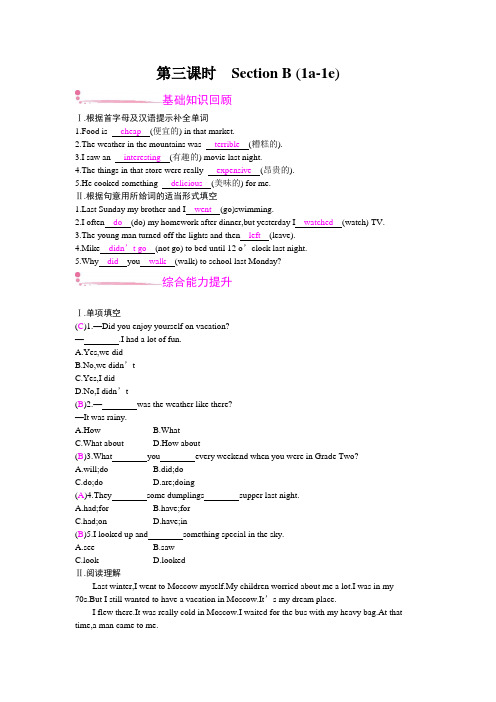
第三课时Section B (1a-1e)基础知识回顾Ⅰ.根据首字母及汉语提示补全单词1.Food is cheap(便宜的) in that market.2.The weather in the mountains was terrible(糟糕的).3.I saw an interesting(有趣的) movie last night.4.The things in that store were really expensive(昂贵的).5.He cooked something delicious(美味的) for me.Ⅱ.根据句意用所给词的适当形式填空st Sunday my brother and I went(go)swimming.2.I often do(do) my homework after dinner,but yesterday I watched(watch) TV.3.The young man turned off the lights and then left(leave).4.Mike didn’t go(not go) to bed until 12 o’clock last night.5.Why did you walk(walk) to school last Monday?综合能力提升Ⅰ.单项填空(C)1.—Did you enjoy yourself on vacation?—.I had a lot of fun.A.Yes,we didB.No,we didn’tC.Yes,I didD.No,I didn’t(B)2.—was the weather like there?—It was rainy.A.HowB.WhatC.What aboutD.How about(B)3.What you every weekend when you were in Grade Two?A.will;doB.did;doC.do;doD.are;doing(A)4.They some dumplings supper last night.A.had;forB.have;forC.had;onD.have;in(B)5.I looked up and something special in the sky.A.seeB.sawC.lookD.lookedⅡ.阅读理解Last winter,I went to Moscow myself.My children worried about me a lot.I was in my 70s.But I still wanted to have a vacation in Moscow.It’s my dream place.I flew there.It was really cold in Moscow.I waited for the bus with my heavy bag.At that time,a man came to me.“May I help you?” he asked.“Yes,thank you,” I said.“Is it OK to help me?I think you are busy making money.” He seemed a taxi driver.“It’s OK.I like helping old people.Hope you have a good time in Moscow,” he said.I couldn’t say anything.I met a good Russian.His English was not good,but we had a great talk on the way to the hotel.When we arrived,I thanked him again and gave him some money.But he didn’t take.“I helped you not for money.I just hope my mom can get help someday,” he said and went away.That’s why I love traveling(旅行).I enjoy visiting beautiful places and meeting kind people.(B)st year,the writer went on a trip to.A.ChinaB.RussiaC.AustraliaD.America(B)2.The writer’s family felt when she went on a trip.A.interestedB.worriedC.boredD.happy(D)3.The writer went there.A.by carB.by busC.by taxiD.by plane(D)4.Why did the man help the writer?A.To make money.B.To make friends.C.To have a great talk.D.To hope someone can help his mom one day.(A)5.What’s the best title for the passage?A.Cold weather,warm heart(心)B.Moscow,a beautiful cityC.It’s never too old to travelD.Little things make a big difference。
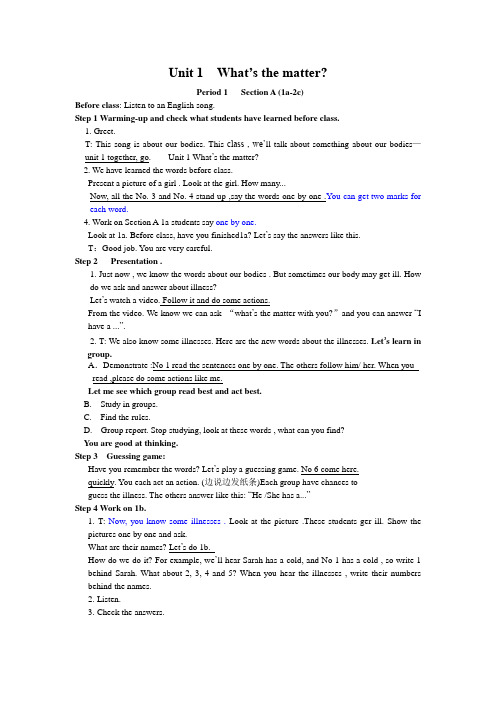
Unit 1 What’s the matter?Period 1 Section A (1a-2c)Before class: Listen to an English song.Step 1 Warming-up and check what students have learned before class.1. Greet.T: This song is about our bodies. This class , we‟ll talk about something about our bodies—unit 1 together, go. Unit 1 What‟s the matter?2. We have learned the words before class.Present a picture of a girl . Look at the girl. How many...Now, all the No. 3 and No. 4 stand up ,say the words one by one .You can get two marks for each word.4. Work on Section A 1a students say one by one.Look at 1a. Before class, have you finished1a? Let‟s say the answers like this.T:Good job. You are very careful.Step 2 Presentation .1. Just now , we know the words about our bodies . But sometimes our body may get ill. Howdo we ask and answer about illness?Let‟s watch a video. Follow it and do some actions.From the video. We know we can ask “what‟s the matter with you?”and you can answer “I have a ...”.2.T: We also know some illnesses. Here are the new words about the illnesses. Let’s learn ingroup.A.Demonstrate :No 1 read the sentences one by one. The others follow him/ her. When you read ,please do some actions like me.Let me see which group read best and act best.B. Study in groups.C. Find the rules.D. Group report. Stop studying, look at these words , what can you find?You are good at thinking.Step 3 Guessing game:Have you remember the words? Let‟s play a guessing game. No 6 come here.quickly. You each act an action. (边说边发纸条)Each group have chances toguess the illness. The others answer like this: “He /She has a...”Step 4 Work on 1b.1. T: Now, you know some illnesses . Look at the picture .These students ger ill. Show thepictures one by one and ask.What are their names? Let‟s do 1b.How do we do it? For example, we‟ll hear Sarah has a cold, and No 1 has a cold , so write 1 behind Sarah. What about 2, 3, 4 and 5? When you hear the illnesses , write their numbers behind the names.2. Listen.3. Check the answers.Step 5 Group work.1. T: Why do they get ill? Look at the chart, match the reasons with the illnesses.2. Check the answers.3. Demonstrate .Look at the chart. Let‟s talk about their illnesses in pairs. Here is the example.Boys ask , girls answer.4. Look at the chart and make more similar conversations.When you talk , please talk loudly, correctly and politely, please do some actions and use the nice intonations.5. Let students show their conversations.Step 6 Work on 2a and 2b.1. T: David has a stomachache, what should he do?Show the pictures ,ask and answer. 板书What should …do? …should….T: Your advice is very useful. Let‟s learn more advice from 2a and 2b.2. Listen, finish 2a. What‟s the matter with the people? What advice do they get?3. First , guess the answers to 2b. Then listen and check the answers.OK, you have good listening skills.Step 7 Group work.The advice for illness is very useful . It can help us take good care of ourselves and others.T: If some students are ill, will you give some advice and help them? let‟s act andmake conversations. Let me see who is the kind person? How do we talk?Look at the example.2. Show the example.When you talk , please talk loudly, correctly and politely, please do some actions and use the nice intonations.3. Students work.4. Let students show their conversations.Step 8 Summarize and homework:Period 2 Section A 2d,GrammarKnowledge aims:1. The students will be able to learn the words and phrases: take breaks, hurt,2.Summarize the grammar and practice them.3. Target Language:①What‟s the matter with Ben? –He hurt himself./ He has a sore back.②-Do you have a fever? -Yes, I do./ No, I don‟t.③-Does he have a toothache? -Yes, he does.④You shouldn‟t eat so much next time.⑤What should she do?⑥She should take her temperature.⑦-Should I put some medicine on it? -Yes, you should. / No, you shouldn‟t.Structure: ①“should/ shouldn‟t + verb” for suggestion ②Reflexive pronouns. Ability Object:1.Enable students to talk more about health.2.Learn to give others some advice according to their matters.3.Enable the students to do things using the target language and the grammar. Emotion Object:1.Learn to live in a healthy way.2. Learn to take care of others and themselves.Teaching Key Points:1. How to teach the Ss to learn the names of the illness: toothache, fever andheadache.2. How to give others some advice according to their matters.3. The grammar.Teaching Difficult Points:1.How to give advice using should.2. Use the grammar to do things.Teaching Procedures:Step 1 Review.1. Free-talk. What …s the weather like today? If you don‟t wear warm clothes,what will happen?2.Show the pictures and say.He / She has_______________. He /She should___________.Step 2 Work on 2d.1. Game.Do in the same way2. Listen to the conversation and answer my questions .1). What's the matter with Lisa?2). What did Lisa do on the weekend?3). What should Lisa do ?3. Role-play the conversation.First, have students to role-play the conversation in 2d in groups and choose the best.Step 3 Group work.1. Give more examples. Have students read the conversation in 4c.2. and then ask them to work in groups. One student mimes a problem. The otherstudents in his/ her group guess the problem and give their advice.Step 4 Grammar Focus .Have students to read and remember the sentences of Grammar Focus by themselves, and then have them work in groups to sum up how to talk about health problems and give right advice.Step5 Work on 4a.Ask students to go through each conversation in 4a quickly, and then complete the conversations individually. Move around the classroom and help them ifnecessary.Check the answers.Ask some students to practice every conversation in pairs.Step 6 Work on 4b.Have students choose and circle best advice for the health problems in 4b. Then ask students add their own advice about these health problems.Have some students to report their own advice in class.Step 7 Summary.Health problems and give right advice.Ask one or two students to sum up the key phrases in the passage, and help them to make up more sentences with them.Step 8 Homework .Have students make up conversations to talk about sb.‟s health problems and give them some advice.Period 3 Section A 3aKnowledge aims:The students will be able to learn the words and phrases: passenger, get off, to one‟s surprise, onto, trouble, hit, right away, get into.2.The students will be able to use the expressions:The driver didn‟t think about thinking about himself. He only thought about saving a life. Ability aims:The students can understand the passage.2.To train the students‟ cooperation with their partners.Emotional aims:To train the students to care about others and help others who are on trouble..Teaching important points:The students can understand the passage and use the useful expressions freely.Teaching difficult points:The students can learn from the drivers and do as the driver does if possible.Teaching procedures:Step 1 Warming-up and lead-in.1. Watch a video.2. What is the short sketch about?3.Look at the picture. What can you see? Can you guess what is happening?Step 2 Preparing reading.1. Guess the main idea.What is this passage mainly about?Strategy : The title and pictures can be helpful to understand the text.Title may be the main meaning of the article.2. Read the passage. Do you think it comes from a newspaper or a book?Step 3 While-reading.1.Find the topic sentence(中心句)of each paragraph.1). At 9:00 a.m. yesterday, bus No. 26 was going along Zhanghua Road when the driver sawan old man lying on the side of the road.2). Some passengers helped Mr. Wang to move the man onto the bus.3). Thanks to Mr. Wang and the passengers, the doctors saved the man in time.2. Which sentences touched you? Read them in the way that you like.Step 4 Post-reading.1. Praise the persons.What a great person the driver was!He stopped the bus without thinking twice, when he saw an old man lying on the side of the road.What _______ the _____ was/were!2. Work on 3bAfter checking the answers, have Ss scan the passage and check (√) the things that happened in the story.3. Work on 3c.T: Ask the students to discuss the questions in pairs.Step5 Homework.1. If you are the driver, write a diary about what happened yesterday.2. If you are the passenger, write a diary about what happened yesterday.3. Act the story out in your group.4. Read some messages about good men.Period 4 Section B 1a-1dStep 1 Lead –in and learn the new words.It‟s a beautiful song, I like it very much. Let‟s learn the new words.1. Who can be the teacher? One student teach one word.2. Let’s sing and remember the new words.The teacher teaches to sing, ask some group to sing. Finally sing together.(可以课前教唱,。
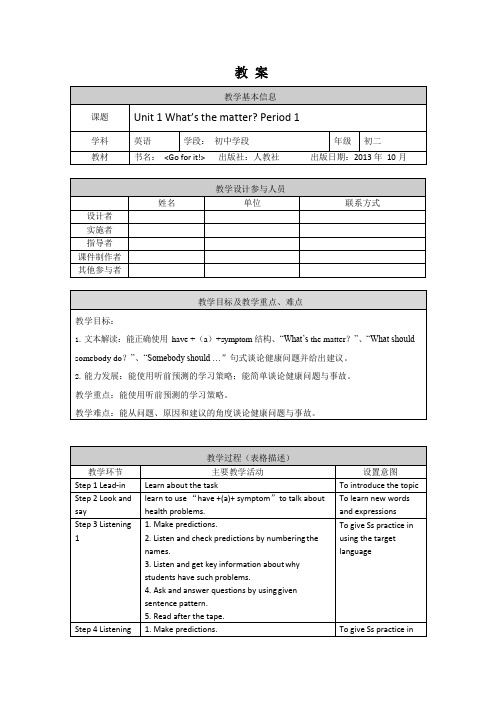
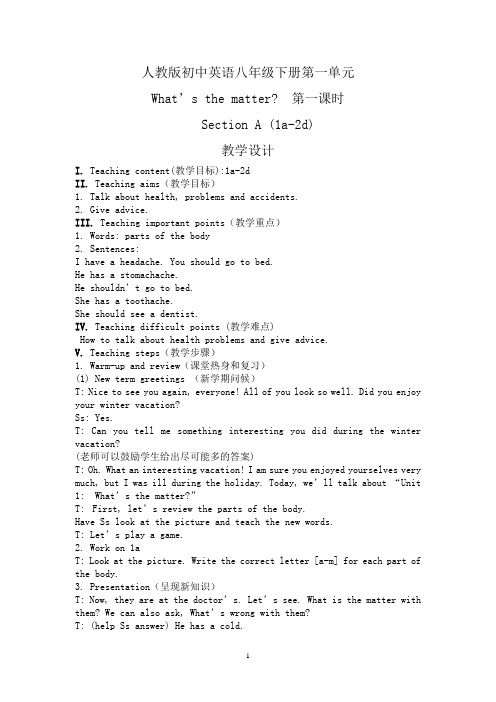
人教版初中英语八年级下册第一单元What’s the matter?第一课时Section A (1a-2d)教学设计I. Teaching content(教学目标):1a-2dII. Teaching aims(教学目标)1. Talk about health, problems and accidents.2. Give advice.III. Teaching important points(教学重点)1. Words: parts of the body2. Sentences:I have a headache. You should go to bed.He has a stomachache.He shouldn’t go to bed.She has a toothache.She should see a dentist.IV. Teaching difficult points (教学难点)How to talk about health problems and give advice.V. Teaching steps(教学步骤)1. Warm-up and review(课堂热身和复习)(1) New term greetings (新学期问候)T: Nice to see you again, everyone! All of you look so well. Did you enjoy your winter vacation?Ss: Yes.T: Can you tell me something interesting you did during the winter vacation?(老师可以鼓励学生给出尽可能多的答案)T: Oh. What an interesting vacation! I am sure you enjoyed yourselves very much, but I was ill during the holiday. Today, we’ll talk about “Unit 1: What’s the matter?”T: First, let’s review the parts of the body.Have Ss look at the picture and teach the new words.T: Let’s play a game.2. Work on 1aT: Look at the picture. Write the correct letter [a-m] for each part of the body.3. Presentation(呈现新知识)T: Now, they are at the doctor’s. Let’s see. What is the matter with them? We can also ask, What’s wrong with them?T: (help Ss answer) He has a cold.T: What should he do?T: He should take some medicine.教师用同样的方法教授其他疾病及相关的建议:1. 胃/肚子疼2. 脖子疼3 头疼4. 嗓子疼, 喉咙疼5. 背疼 6. 感冒7. 发高/低烧 8.咳嗽9.牙痛4. Work on 1cPresent the picture and have Ss to do the pair work.总结各种疾病及如何给出建议和句型。
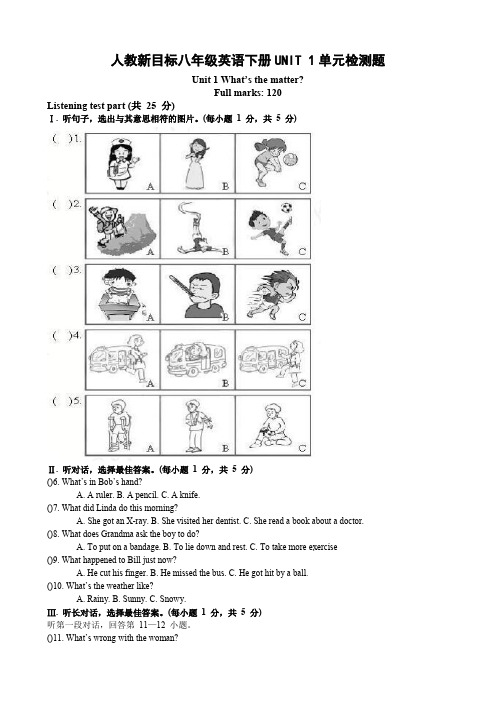
人教新目标八年级英语下册UNIT 1单元检测题Unit 1 What’s the matter?Full marks: 120Listening test part (共25 分)Ⅰ. 听句子,选出与其意思相符的图片。
(每小题 1 分,共 5 分)Ⅱ. 听对话,选择最佳答案。
(每小题 1 分,共 5 分)()6. What’s in Bob’s hand?A. A ruler.B. A pencil.C. A knife.()7. What did Linda do this morning?A. She got an X-ray.B. She visited her dentist.C. She read a book about a doctor. ()8. What does Grandma ask the boy to do?A. To put on a bandage.B. To lie down and rest.C. To take more exercise()9. What happened to Bill just now?A. He cut his finger.B. He missed the bus.C. He got hit by a ball.()10. What’s the weather like?A. Rainy.B. Sunny.C. Snowy.Ⅲ. 听长对话,选择最佳答案。
(每小题 1 分,共5 分)听第一段对话,回答第11—12 小题。
()11. What’s wrong with the woman?A. She has a sore back.B. She has a stomachache.C. She has a headache and coughs.()12. How long was the woman ill?A. For two days.B. For three days.C. For four days.听第二段对话,回答第13—15 小题。
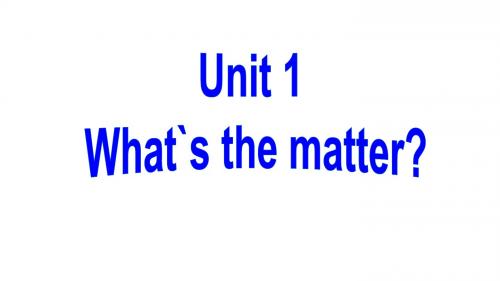
新版人教版八年下英语Unit1Whatsthematter课文原文Unit 1 What’s the matter?1. Mandy:Lisa,are you OK?Lisa:I have a headache and I can’t move my neck.What should I do?Should I take my temperature? Mandy:No,it doesn’t sound like you have a fever.What did you on eht eweekend?Lisa:I played computer games all weekend.Mandy:That’s probably why.You need to take breaks away from the computer.Lisa:Yeah,I think I sat in the same way for too long without moving.Mandy:I think you should lie down and rest.If your head and neck still hurt tomorrow, then go to a doctor.Lisa:OK.Thanks ,Mandy.2.At 9 :00a.m,yesterday,bus No.26 was going along Zhonghua Road when the driver saw an old man lying on the side of the road.A woman next to him was shouting for help.The bus driver ,24-year-old Wang Ping,stopped the bus without thinking twice. He got off and asked the woman what happened.She said that the man had a heart problem and should go to the hospital.Mr. Wang knew he had to act quickly.He told the passengers that he must take the man to the hospital.He expected most or all of the passengers to get off and wait for next bus.But to his surprise,they all agreed to go to with him.Some passengers helped Mr.Wang to move the man onto the bus.Thanks to Mr. Wang and the passengers,the doctors saved the man in time.“It’s sad that many people don’t want to helpothers because they don’t want any trouble,″says one passenger.“But the driver didn’t think about himself.He only t hought about saving a life.″3.He lost His Arm But Is Still ClimbingAron Ralston is an American man w ho is interested in mountain climbing. As a mountain climber, Aron is used to taking risks. This is one of the exciting things about doing dangerous sports. There were many times when Aron almost lost his life because of accidents. On April 26, 2003, he found himself in a very dangerous situation when climbing in Utah.On that day, Aron’s arm was caught under a 360-Kilo rock that fell on him when he was climbing by himself in the mountains. Because he could not free his arm, he stayed there for five days and hoped that someone would find him. But when his water ran out, he knew that he would have to do something to save his own life. He wasn’t ready to die that day. So he used his knife to cut off half his right arm. Then, with his left arm, he bandaged himself so that he wouldn’t lose too much blood. After that, he climbed down the mountain to find help, After losing his arm, he wrote a book called Between a Rock and Hard Place. This means being in a difficult situation that you can’t seem to get out of. In this book, Aron tells of the importance of making good decisions, and of being in control of one’s life. His love for mountain climbing is so great that he kept on climbing mountains even after this experience.Do we have the same spirit as Aron? Let’s think about it before we find ourselves “between a rock and a hard place”, and before we have to make a decision that could mean life or death.。
Unit1 What ' s the matt?er1. What ' t the matter ? 怎么了?matter 此处为可数名词,意为“毛病;麻烦”,通常用于句型What' s the matter with sb. 中? 。
该问句常用来询问某人患了何种疾病或遇到了何种麻烦。
—What ' s the matter with him ? 他怎么了?—He has a headache . 他头痛。
拓展:(jmatter还可作为不及物动词,意为要紧,有关系”,主要用于否定句,疑问句或者条件句中。
It doesn ' t matt没有关系。
Does it matter if I ' m a bit late ? 我晚一会到有关系吗?◎.no matter 与who , what , where 等连用,相当于whoever , whatever ‘wherever 等, 可引导让步状语从句。
Don' t open the door , no matter who comes .不管谁来都别开口。
2. I have stomachache . 我胃痛。
Stomachache 为可数名词,意为“胃痛;腹痛”Eg: Mary didn ' t come to school yesterday because she had a stomachache. 拓展:在英语中,一部分表示身体部位的名词加上名词ache (疼痛)后,可以构成合成名词。
女口headache头痛,toothache 牙痛,stomachache 胃痛,backache 背痛,earache耳朵痛。
3. She talked too much yesterday and didn ' t drink eno她昨wO说话太多,并且没有喝足够的水。
(1) 此处too much 相当于一个副词,修饰动词talked ,放在后面作状语,意为“太多”。
Unit 1 What’s the matter?Period 1 Section A (1a-2c)Before class: Listen to an English song.Step 1 Warming-up and check what students have learned before class.1. Greet.T: This song is about our bodies. This class , we‟ll talk about something about our bodies—unit 1 together, go. Unit 1 What‟s the matter?2. We have learned the words before class.Present a picture of a girl . Look at the girl. How many...Now, all the No. 3 and No. 4 stand up ,say the words one by one .You can get two marks for each word.4. Work on Section A 1a students say one by one.Look at 1a. Before class, have you finished1a? Let‟s say the answers like this.T:Good job. You are very careful.Step 2 Presentation .1. Just now , we know the words about our bodies . But sometimes our body may get ill. Howdo we ask and answer about illness?Let‟s watch a video. Follow it and do some actions.From the video. We know we can ask “what‟s the matter with you?”and you can answer “I have a ...”.2.T: We also know some illnesses. Here are the new words about the illnesses. Let’s learn ingroup.A.Demonstrate :No 1 read the sentences one by one. The others follow him/ her. When you read ,please do some actions like me.Let me see which group read best and act best.B. Study in groups.C. Find the rules.D. Group report. Stop studying, look at these words , what can you find?You are good at thinking.Step 3 Guessing game:Have you remember the words? Let‟s play a guessing game. No 6 come here.quickly. You each act an action. (边说边发纸条)Each group have chances toguess the illness. The others answer like this: “He /She has a...”Step 4 Work on 1b.1. T: Now, you know some illnesses . Look at the picture .These students ger ill. Show thepictures one by one and ask.What are their names? Let‟s do 1b.How do we do it? For example, we‟ll hear Sarah has a cold, and No 1 has a cold , so write 1 behind Sarah. What about 2, 3, 4 and 5? When you hear the illnesses , write their numbers behind the names.2. Listen.3. Check the answers.Step 5 Group work.1. T: Why do they get ill? Look at the chart, match the reasons with the illnesses.2. Check the answers.3. Demonstrate .Look at the chart. Let‟s talk about their illnesses in pairs. Here is the example.Boys ask , girls answer.4. Look at the chart and make more similar conversations.When you talk , please talk loudly, correctly and politely, please do some actions and use the nice intonations.5. Let students show their conversations.Step 6 Work on 2a and 2b.1. T: David has a stomachache, what should he do?Show the pictures ,ask and answer. 板书What should …do? …should….T: Your advice is very useful. Let‟s learn more advice from 2a and 2b.2. Listen, finish 2a. What‟s the matter with the people? What advice do they get?3. First , guess the answers to 2b. Then listen and check the answers.OK, you have good listening skills.Step 7 Group work.The advice for illness is very useful . It can help us take good care of ourselves and others.T: If some students are ill, will you give some advice and help them? let‟s act andmake conversations. Let me see who is the kind person? How do we talk?Look at the example.2. Show the example.When you talk , please talk loudly, correctly and politely, please do some actions and use the nice intonations.3. Students work.4. Let students show their conversations.Step 8 Summarize and homework:Period 2 Section A 2d,GrammarKnowledge aims:1. The students will be able to learn the words and phrases: take breaks, hurt,2.Summarize the grammar and practice them.3. Target Language:①What‟s the matter with Ben? –He hurt himself./ He has a sore back.②-Do you have a fever? -Yes, I do./ No, I don‟t.③-Does he have a toothache? -Yes, he does.④You shouldn‟t eat so much next time.⑤What should she do?⑥She should take her temperature.⑦-Should I put some medicine on it? -Yes, you should. / No, you shouldn‟t.Structure: ①“should/ shouldn‟t + verb” for suggestion ②Reflexive pronouns. Ability Object:1.Enable students to talk more about health.2.Learn to give others some advice according to their matters.3.Enable the students to do things using the target language and the grammar. Emotion Object:1.Learn to live in a healthy way.2. Learn to take care of others and themselves.Teaching Key Points:1. How to teach the Ss to learn the names of the illness: toothache, fever andheadache.2. How to give others some advice according to their matters.3. The grammar.Teaching Difficult Points:1.How to give advice using should.2. Use the grammar to do things.Teaching Procedures:Step 1 Review.1. Free-talk. What …s the weather like today? If you don‟t wear warm clothes,what will happen?2.Show the pictures and say.He / She has_______________. He /She should___________.Step 2 Work on 2d.1. Game.Do in the same way2. Listen to the conversation and answer my questions .1). What's the matter with Lisa?2). What did Lisa do on the weekend?3). What should Lisa do ?3. Role-play the conversation.First, have students to role-play the conversation in 2d in groups and choose the best.Step 3 Group work.1. Give more examples. Have students read the conversation in 4c.2. and then ask them to work in groups. One student mimes a problem. The otherstudents in his/ her group guess the problem and give their advice.Step 4 Grammar Focus .Have students to read and remember the sentences of Grammar Focus by themselves, and then have them work in groups to sum up how to talk about health problems and give right advice.Step5 Work on 4a.Ask students to go through each conversation in 4a quickly, and then complete the conversations individually. Move around the classroom and help them ifnecessary.Check the answers.Ask some students to practice every conversation in pairs.Step 6 Work on 4b.Have students choose and circle best advice for the health problems in 4b. Then ask students add their own advice about these health problems.Have some students to report their own advice in class.Step 7 Summary.Health problems and give right advice.Ask one or two students to sum up the key phrases in the passage, and help them to make up more sentences with them.Step 8 Homework .Have students make up conversations to talk about sb.‟s health problems and give them some advice.Period 3 Section A 3aKnowledge aims:The students will be able to learn the words and phrases: passenger, get off, to one‟s surprise, onto, trouble, hit, right away, get into.2.The students will be able to use the expressions:The driver didn‟t think about thinking about himself. He only thought about saving a life. Ability aims:The students can understand the passage.2.To train the students‟ cooperation with their partners.Emotional aims:To train the students to care about others and help others who are on trouble..Teaching important points:The students can understand the passage and use the useful expressions freely.Teaching difficult points:The students can learn from the drivers and do as the driver does if possible.Teaching procedures:Step 1 Warming-up and lead-in.1. Watch a video.2. What is the short sketch about?3.Look at the picture. What can you see? Can you guess what is happening?Step 2 Preparing reading.1. Guess the main idea.What is this passage mainly about?Strategy : The title and pictures can be helpful to understand the text.Title may be the main meaning of the article.2. Read the passage. Do you think it comes from a newspaper or a book?Step 3 While-reading.1.Find the topic sentence(中心句)of each paragraph.1). At 9:00 a.m. yesterday, bus No. 26 was going along Zhanghua Road when the driver sawan old man lying on the side of the road.2). Some passengers helped Mr. Wang to move the man onto the bus.3). Thanks to Mr. Wang and the passengers, the doctors saved the man in time.2. Which sentences touched you? Read them in the way that you like.Step 4 Post-reading.1. Praise the persons.What a great person the driver was!He stopped the bus without thinking twice, when he saw an old man lying on the side of the road.What _______ the _____ was/were!2. Work on 3bAfter checking the answers, have Ss scan the passage and check (√) the things that happened in the story.3. Work on 3c.T: Ask the students to discuss the questions in pairs.Step5 Homework.1. If you are the driver, write a diary about what happened yesterday.2. If you are the passenger, write a diary about what happened yesterday.3. Act the story out in your group.4. Read some messages about good men.Period 4 Section B 1a-1dStep 1 Lead –in and learn the new words.It‟s a beautiful song, I like it very much. Let‟s learn the new words.1. Who can be the teacher? One student teach one word.2. Let’s sing and remember the new words.The teacher teaches to sing, ask some group to sing. Finally sing together.(可以课前教唱,。